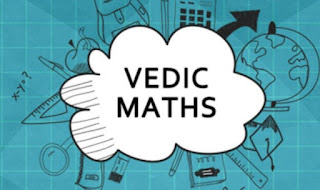VEDIC MATHS
By OMKAR TENDOLKAR
Hello friends,
This is post number 41 from the series of "Vedic maths" blogs. Here in this blog we will learn about "Simultaneous Linear Equations part-2".
In the previous blog we studied how to solve two types of basic equations. In this blog we will study how to solve simultaneous linear equations.
What Are Simultaneous Linear Equations?
Simultaneous linear equations have two variables in them. Let us say x and y. Since there are two variables in the equation we cannot solve it by itself. We need another equation with the same variable values to find the answer. When these two equations are solved together we get the values of the variables x and y.
In the traditional method a new set of equations is formed in order to equalize the coefficients of any one variable. But forming new equations is a time-consuming procedure. Secondly, equalizing the coefficients is not always an easy task. If the coefficients have big numbers or decimal values it. becomes very difficult to equalize them by multiplying them with suitable numbers. the possibility of making a mistake with this method is pretty high.
Here in this blog we will study the Vedic approach to solving simultaneous linear equations.
Reference:
We had already learn about "Simultaneous Linear Equations part-1" our previous blog. If you have missed my last blog then please visit "VEDIC MATHS-41". Method:
In this method we will not be forming new equations but instead we will calculate the values of x and y with the given equations only. The value of the variables x and y will be expressed in the form of numerator upon denominator.
Numerator
x = ----------------------- ;
Denominator
Numerator
y = ----------------------- ;
Denominator
It should be noted that although one can find the values of both x and y there is no need for doing it. If we obtain the value of either x or y then the value of the other variable can easily be obtained by substitution.
Calculating the value of 'y'
1) Find the values of x and y for the equations 6x + 4y = 50 and 5x + 5y = 50
6x + 4y = 50 .....(1)
5x + 5y = 50 .....(2)
6x + 4y = 50 .....(1)
5x + 5y = 50 .....(2)
The numerator is obtained by cross-multiplying (5 × 50) and subtracting from it the cross product of (50 × 6).
(5 × 50) - (50 × 6) -50
y = --------------------------------- = ---------------------
Denominator Denominator
6x + 4y = 50 .....(1)
5x + 5y = 50 .....(2)
The numerator is obtained by cross-multiplying (5 × 4) and subtracting from it the cross product of (6 × 5)
-50 -50
y = --------------------------- = ------- = 5
(5 × 4) - (6 × 5) -10
In this case, we have obtained the value of y as 5. We substitute the value of y in equation (1) and
get the value of x as 5. The solution set is (5, 5).
Solution:
x=5,y=5.
2) Find the values of x and y for the equations 5x + 4y = 3 and 2x - 3y = -8
5x + 4y = 3 .....(1)
2x - 3y = -8 .....(2)
5x + 4y = 3 .....(1)
2x - 3y = -8 .....(2)
The numerator is obtained by cross-multiplying (3 × -2) and subtracting from it the cross product of (5 × -8)
(3 × 2) - (5 × -8) 46
y = --------------------------- = ------------------------
Denominator Denominator
5x + 4y = 3 .....(1)
2x - 3y = -8 .....(2)
The numerator is obtained by cross-multiplying (2 × 4) and subtracting from it the cross product of (-3 × 5)
46 46
y = --------------------------- = ------- = 2
(2 × 4) - (-3 × 5) 23
In this case, we have obtained the value of y as 2. We substitute the value of y in equation (1) and
get the value of x as -1. The solution set is (-1,2).
Solution:
x=-1, y=2
Solve the next three equations by calculating for y. Write the answer in the form of (value of x, value of y).
1. 7x + 2y = 19 and 4x + 3y = 22
2. 2x + 9y = 27 and 4x + 4y = 26
3.40x + 20y = 400 and 80x + 10y = 500
You may answer this in comment box. You may ask your any query or doubt in comment box. I will try to resolve as early as possible.
In next blog we will discuss about "Simultaneous Linear Equations part-3".
Thanks
for giving your valuable time.
Good day😊.


Comments
Post a Comment